The stairs we used had been carved out at least a couple millennia ago, which was helpful. But with my annoying heart arrythmia that's exercise induced, particularly on steep inclines or stair climbs, I had to stop every so often to do my "tricks" to get my heart rate back into a normal range. Once we get past this pandemic, I'm gonna have to follow up with a cardiologist to schedule heart ablation. I've still got places to travel and things to see, and not all at sea level!
Once we got near the sacrificial place, the stairs ended and you had to bear crawl the final 25 steps or so. No handrails. Nothing to catch you if you lost your footing. So daughter A did her spider monkey climb to the tip-top and I took her word for it that it was a lovely view. As we started our descent, we either missed or misread a sign. We saw some amazing vistas, but we just kept twisting and turning, with no idea where we were headed and no further signage to guide us. Or cell service.
And so there was no choice but to just keep swimming walking. We passed some amazing entrance doors along the way. My favorite pic was standing in a tomb and taking a pic out its door across to a different tomb's doorway. Eventually a teenaged Bedouin girl walking towards us was able to point us back to the main tourist avenue via a trail coming in behind the old Roman colonnaded street.
We saw quite a few critters in Petra, namely donkeys, camels and goats. And a couple friendly cats who kept me company when I stopped to lower my heart rate.
Then there was this donkey, below, who was clip clopping along the trail when we were lost, no rider in sight.
Finally, I want to share with you the church remains we toured in Petra. Built in approximately 450 AD, it stood for 150 years before fire destroyed most of it in 600. The ruins of the church are covered and you can still see the mosaic floors as well as the baptistry.
Thanks to our Muslim guide Nidal, I now know the biblical connection to the treasury believed to be the tomb of Nabataean king Aretas. The king's daughter Phasaelis was married to Herod Antipas. However, Herod decided to divorce her and marry Herodias, mother of Salome. So Phasaelis fled home to Petra and told her father. Aretas invaded Herod's domain and defeated his army.
Now the biblical connection to John the Baptist... In Matthew 14, Herod had John the Baptist arrested and imprisoned at the behest of his wife Herodias. John spoke out against Herod marrying her. Herod didn't immediately execute John because he was afraid to since the people considered John a prophet. But after Herodias' daughter Salome did her dance for Herod and his guests at his birthday dinner, Herod promised Salome whatever she wished. After conferring with her mother, Salome requested John the Baptists's head on a platter. Despite his distress, Herod didn't want to lose face in front of his guests and so he had John beheaded and his head brought on a platter and presented to Salome and Herodias. John's disciples came and took his body to bury. Then they went and told Jesus.
Aretas is also mentioned in 2 Corinthians 11:32... In Damascus the governor under King Aretas had the city of Damascenes guarded in order to arrest me (Paul). I absolutely love it when historical accounts and facts support events in the Bible, God's word!















































































